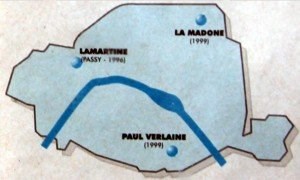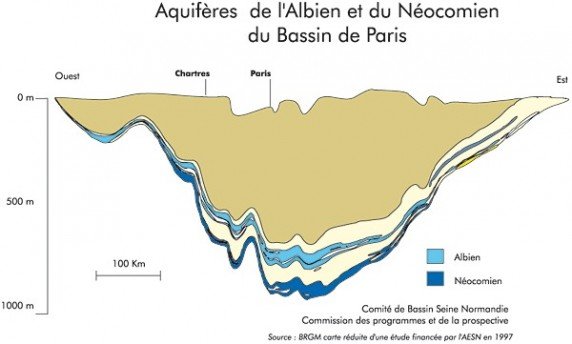
 Version française
Version française
La réalisation de puits artésiens à Paris a été rendue possible par la présence de la nappe aquifère de l'Albien et les progrès des techniques de forage à partir des années 1830. La volonté de produire une eau saine à bon marché fit apparaître des puits artésiens tout au long du xixe siècle et au début du xxe. La seconde moitié du xxe siècle vit l'expansion d'une nouvelle génération de puits artésiens, à des fins de chauffage géothermique.
Il existe 3 puits artésiens ouverts au public à Paris, et dont il y a déjà 2 earthcaches :
Cette earthcache vous permettra de visiter la 3ème source Albienne.

Puits artésien de la Madone
Ce troisième puits artésien, situé à proximité de la fontaine du square Tristan-Tzara, 18e arrondissement, mit à profit l’évolution des moyens techniques : son diamètre était beaucoup plus important que celui de ses prédécesseurs, atteignant finalement 1,06 m. Le forage commença en 1863, mais ne fut achevé qu’en 1891. On rencontra en effet d’énormes difficultés dues essentiellement à la structure géologique du lieu : il fallut percer jusqu’à une profondeur de 718 m pour trouver les sables aquifères de l’Albien. L’eau est de composition semblable à celle des puits précédents, mais sa température atteint 30 °C. Elle alimentait la piscine Hébert, ouverte en 1893.
Le système aquifère Albien-Néocomien

La nappe de l'Albien du bassin de Paris est une nappe d'eau souterraine captive profonde présente dans une grande partie du bassin parisien. Cette nappe, qui se trouve dans des aquifères du Crétacé inférieur, est en connexion hydraulique avec la nappe sous-jacente du Néocomien. Elle contient d'importante réserves d'eau de bonne qualité, estimées à 700 milliards de m³.
Qu'est ce qu'un aquifère ?
Un aquifère est une formation géologique ou une roche, suffisamment poreuse et/ou fissurée (qui peut stocker de l'eau) et perméable (où l'eau circule librement), pour contenir, de façon temporaire, ou permanente une nappe d'eau souterraine mobilisable (on ne parle d'aquifère que si la formation est capable de restituer cette eau naturellement et/ou par exploitation comme un drainage, pompage,...).
Pour valider votre visite vous devez répondre aux questions suivantes et envoyer vos réponses uniquement par email à l'owner (Et non par la messagerie de Groundspeak) :
- Quel est le type d'aquifère de la nappe d'Albien ?
- Quelle est la profondeur moyenne de la nappe à Paris ?
- Quelle est la date exacte du début du premier forage, ainsi que la profondeur atteinte pour ce forage ?
- Non loin de la fontaine se trouve quelques informations. Quelle est la date du prélèvement, le pH relevé et la conductivité à 25°C ?
- Optionnel mais apprécié : Une photo de vous ou de votre GPS devant la fontaine.
Un log n'ayant pas répondu aux exigences demandées sera supprimé sans avertissement.
 English version
English version
Achieving artesian wells in Paris was made possible by the presence of the aquifer Albian and advances in drilling techniques from the 1830's will produce clean water cheaply conjured all of artesian wells throughout the 19th century and early 20th. The second half of the 20th century saw the expansion of a new generation of artesian wells, for geothermal heating.
There are 3 water wells open to the public in Paris, and there are already 2 earthcaches:
This earthcache allow you to visit the 3rd Albian spring water.

Artesian wells of the Madonna
This third artesian well, located near the fountain of Tristan Tzara-square, 18th arrondissement, took advantage of the technical developments: its diameter was much larger than its predecessors, finally reaching 1.06 m. Drilling began in 1863 but was not completed until 1891 were indeed met enormous difficulties mainly due to the geological structure of the place. Had it drilled to a depth of 718 m to find the aquifer sands of Albian. The composition of water is similar to previous wells, but its temperature reaches 30 ° C. She fed pool Hébert, opened in 1893.
The Albian-Neocomian aquifer system

The web of the Albian of the Paris Basin is a groundwater deep confined present in much of the Paris basin. This sheet, which is located in the Lower Cretaceous aquifer is in hydraulic connection with the underlying groundwater Neocomian. It contains large reserves of good quality water, estimated at 700 billion cubic meters.
What is an aquifer?
An aquifer is a geological formation or a rock, sufficiently porous and / or cracked (which can store water) and permeable (where water flows freely), to contain, temporary, or permanent bodies of water underground mobilized (we only speak aquifer that if training is capable of reproducing naturally the water and / or operating as a drainage pump ...).
To validate your visit you must answer the following questions and send answers only by email to the owner (Not by the Message Center):
- What is the type of aquifer groundwater of Albian?
- What is the average depth of the water in Paris?
- What is the exact date of the first hole and the depth reached for drilling?
- Not far from the fountain is some information. What is the date of collection, pH and conductivity observed at 25 ° C?
- Optional but appreciated: Please, provide a picture of you or your GPS in front of fountain
A log which has not met the requested requirements will be deleted without warning.